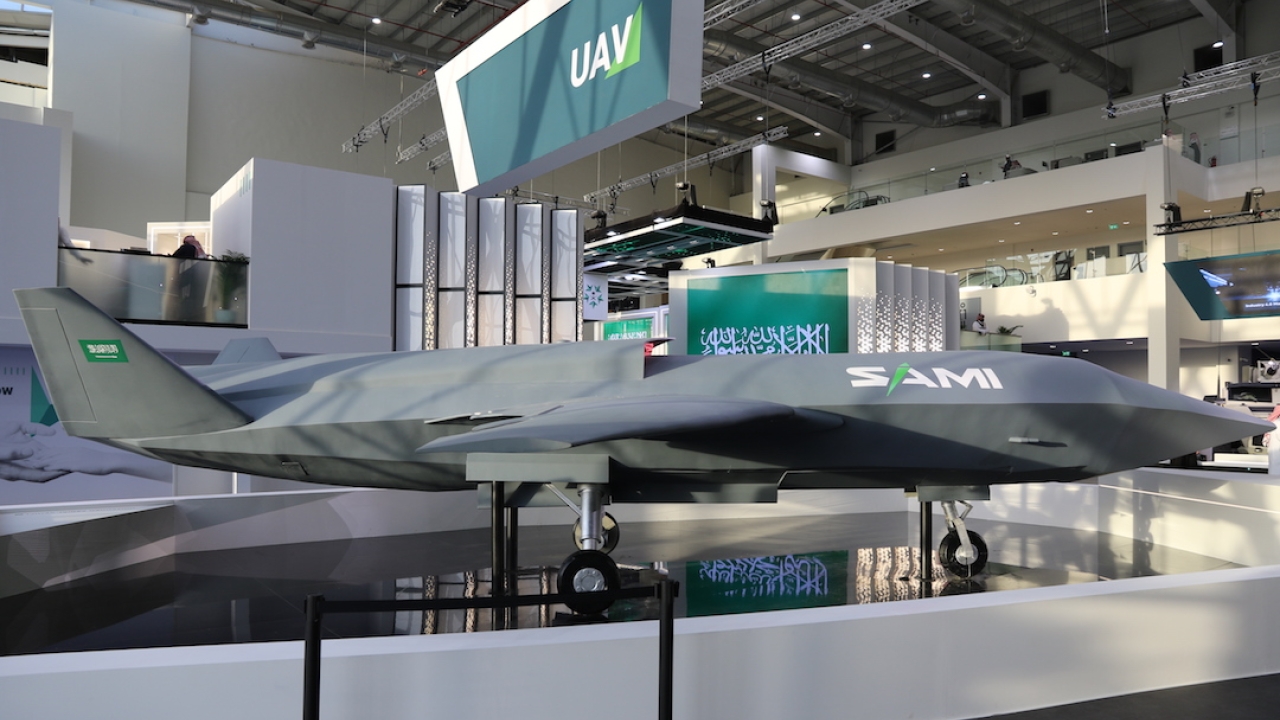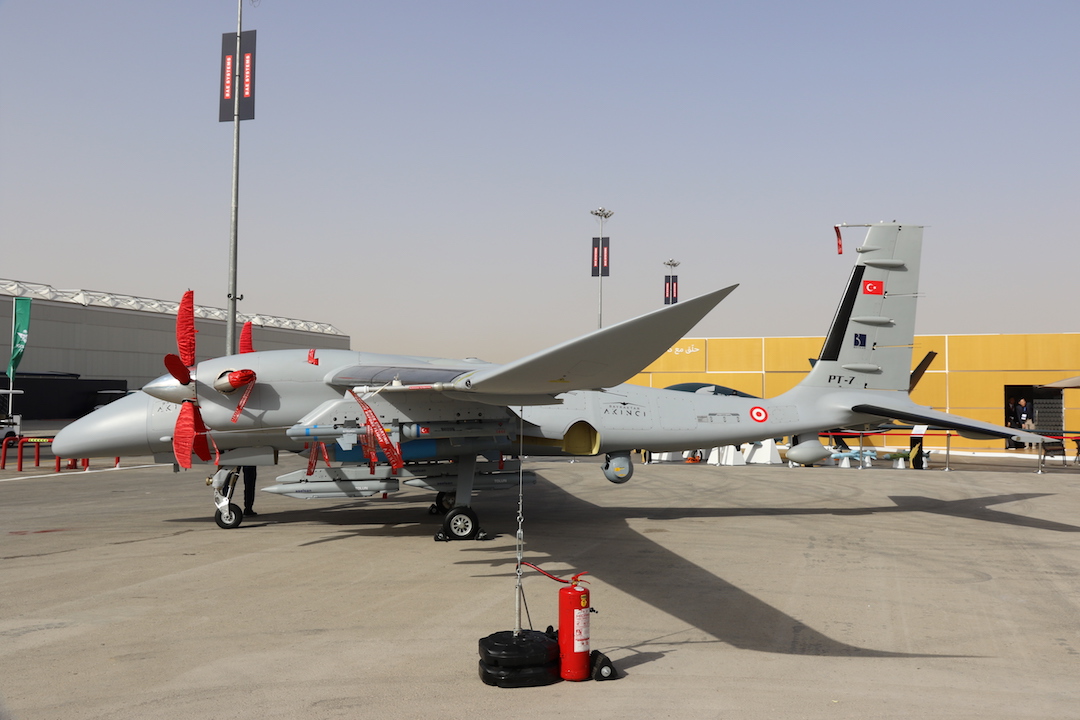SAMI's in the fast lane to Vision 2030
Saudi Arabia’s SAMI (Saudi Arabia Military Industries), a Saudi Public Investment, created in January 2018 is expanding at quite a ferocious pace. That’s been a priority for CEO Walid Abukhaled, who has worked hard to ensure SAMI meets the objectives of Saudi Vision 2030, with the need to localise 50 per cent of Saudi’s defence spending a top priority. Alan Warnes investigates.

SAMI Aerospace has big ambitions in the unmanned aerial vehicle sector, with this UCAV being the centre of attention at the SAMI stand. PICTURE: Alan Warnes
In February 2022, that number stood at three per cent, today the figure is 15 per cent and SAMI is managing to increase that percentage by setting up joint ventures – 11 of them to date, with US, European and South Korean companies as one route.
The most recent being the agreement between the Saudi MOD and Turkey’s Baykar, which will allow SAMI to assemble the Bayraktar Akinci twin turboprop unmanned aircraft system (UAS). The SAMI CEO told reporters during Dubai Air Show last year, “We will build the Akinci airframe, produce the avionics, cabling and harnesses, to manufacture the aircraft in Saudi Arabia.”
He added that the domestic development of UAS products was a priority and a ‘strategic element’ in SAMI’s aerospace business. The recent World Defense Show, held in Riyadh from February 4-8, saw its ambitions in the shape of a futuristic unmanned combat aerial vehicle that one source claimed could be flying within two years.
There are many strains to SAMI Aerospace. On October 24 last year, the commander of the Royal Saudi Air Force, Prince Turki bin Bandar unveiled a new strategy and identity for the newly-created SAMI Aerospace Mechanics following the acquisition of Aircraft Accessories and Components Co in early 2023.
Speaking on the occasion, he said: “We all understand the importance of the role national companies play in building local capabilities and competencies in the field of aircraft maintenance.
“The role of the workers in these factories is just as important as the role of our soldiers in maintaining the security and safety of our country, so I would like to thank everyone who has contributed to this important transformation.”
The SAMI Aerospace chairman, Abdulsalam Al-Ghamdi, said: “Today we celebrate the launch of a new strategy and identity for SAMI Aerospace Mechanics, which we believe transitions us from a defense-centric MRO to a formidable player on the global civil and defence aviation stage, and a major contributor to achieving a transformation in the aerospace centre.”
Meanwhile, the acquisition of Alsalam Aerospace Industries is all but completed, with an announcement on the cards for quite a while now. Alsalam based in Riyadh is a provider of aircraft maintenance, repair and overhaul services as well as upgrading the Boeing F-15S/SA Eagle.
The company performs heavy maintenance and modification on civil and military aircraft at its facilities in Riyadh, Saudi Arabia and has three climate-controlled widebody hangars with dedicated military hangars with a wide range of support shop capabilities including composite repairs.
Another major Saudi aerospace company, Advanced Electronics Company (AEC) was acquired by SAMI in December 2020 and rebranded SAMI Advanced Electronics.
It was the biggest military industries deal ever concluded in Saudi Arabia. Specialising in the likes of modern electronics like radars, as well as digital and security services and military satellite systems, will allow SAMI to build up another pillar, and integrate into its vision.
Rebranding of the new businesses was evident at the SAMI Aerospace stand at WDS in February – with Alsalam Aerospace Industries referred to as SAMI Aerospace Airframes.
Abullah Almaghlooth, director SAMI Aerospace - Airframes division, is part of the team that manages and establishes a clear strategy of the MRO, formerly Alsalam Aircraft Industries, but preferred to discuss the new division not the individual parts that SAMI has rebranded.
“SAMI Aerospace Airframes is responsible for the maintenance, repair and overhaul of several aircraft platforms in addition to supervising the supply chain that feeds into that. We have great capabilities that have been developed and upscaled by SAMI.
“As part of those responsibilities, we maintain mechanical components such as fuel systems and propellers. There is also the airframe repair and overhaul, in addition to unscheduled and scheduled depot maintenance.”

SAMI Aeropsace Airframes has two main hubs according to Almaghlooth without wanting to name them although one is known to be at King Khalid International airport where the bulk of the MRO work is caried out. That is in addition to the military bases, where SAMI engineers carry out both first- and second-line maintenance.
“We look after the likes of F-15s, Typhoons, Hawks, C-130s, E-3 AWACS, 707 tankers, and A330 Multirole Tanker Transport (MRTT) in addition to helicopters. We are building up great capabilities on the latter, like airframe maintenance, technical support and technical supply for the AS 332 Super Pumas and AS 565MB Panthers.”
SAMI has of course been involved in the Boeing F-15S to F-15SA Eagle upgrade and Almaghlooth said, “We have done a lot of great work on the upgrade – it’s very complex and the work has to be precise, like disassembly and assembly of these aircraft and manufacturing of the wings and fuselage.”
Boeing told the author that if the US aerospace giant was to win an order for 54 F-15EX Eagle IIs, then SAMI could be involved in the upgrade of existing F-15SAs too.
“Interesting,” said Almaghlooth, “But I’m not really part of that vision, at the end of the day it’s a government decision, and I’m sure they will make the right one, not only in terms of the great capabilities but more importantly on what it will add to the country in terms of localisation. I mean in terms of skills and production, when we can build the people and facilities.
“We have been doing a lot of localisation for the past 30 years, so its not something new for us. It is very important to look into what the added value is on top of what has been done over the past 30 years. That is the most important thing.”
WDS of course celebrated the end of the RSAF Hawk assembly line at King Faisal Air Base, Tabuk, so it means the facility there is now all but empty. There were plans to assemble the Typhoon there several years ago, that were eventually abandoned.
Now with the likelihood that the RSAF will acquire at least 54 Eurofighter Typhoons, there is a possibility that Typhoon assembly is back on the table, and where better to do that than at the site where the Tornado sustainment programme upgrades were carried out and BAE Hawks were assembled.
Could SAMI Aerospace support whatever happens there next? “It’s a BAE facility,” Almaghloot said, adding “but SAMI could support and be willing to help and do as much as possible to ensure that the capabilities built up over the past five years under BAE Systems is not lost. Something will happen there for sure.”
He continued: “There is always a way to redeploy people and make use of their capabilities. Of course, it would be great if you have a continuous programme to follow on, but you know things take time. I’m pretty sure those capabilities will not be lost by the country. We will capitalise on and utilise them elsewhere whether its for maintenance, for an engineering capability or transferring the know-how to a new generation so they can make use of it.”
The SAMI Aerospace Airframes director finished: “We have good ambitions and we are looking forward to building our capabilities that will being value to our people and enhance the defensive needs of the country.”
Stay up to date
Subscribe to the free Times Aerospace newsletter and receive the latest content every week. We'll never share your email address.

